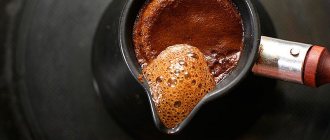There is a popular belief that coffee with milk is healthier than black coffee:
- it is less strong;
- has a neutral taste.
Even on Instagram, a photo of a cappuccino with a pattern on the milk foam gets more likes than a masculine, stern espresso. True, biologists, doctors and coffee professionals have several arguments in favor of coffee without milk, and we decided to go through each one. And don't be shy - the comments are open to your thoughts on this matter.
Milk kills antioxidants
With antioxidants, the opposite is true. Unfortunately, the milk protein casein enters into a chemical reaction with polyphenolic compounds and neutralizes their effect on the body. You will get pleasure from lavender raffa, but it is unlikely that you will get the same benefits as from Americano.
But coffee is one of the richest drinks in the world in antioxidants! Tannins, phenolic compounds that have a tanning effect, are responsible for its antioxidant activity. We wrote about this in more detail here.
What counteracts the effects of caffeine
How to neutralize caffeine and its effects in the body if you have drunk too much? There are several ways to do this:
- Plain water, as mentioned above. If a person feels unwell, has stomach problems or heaviness in the pancreas, he should immediately drink half a liter of liquid.
- Spices, but here you need to observe moderation. Excessive consumption is contraindicated for people with gastrointestinal problems.
- Milk. It is not recommended for people who are watching their figure, because the drink is very high in calories, especially after adding sugar.
If a person is not used to drinking coffee, then it is better for him to order a decaffeinated portion for the first time. Some people do this because they prefer the taste of the grains rather than the stimulating effect. Others purposefully drink a strong drink to get a boost of energy for 3 to 4 hours.
Spices
How to reduce or neutralize caffeine in the body using spices - suitable for this:
- ginger;
- cardamom;
- cinnamon.
Sometimes hot seasonings are added to espresso - black pepper and chili. This combination can cause exacerbation of gastritis or ulcers, so you need to try it carefully.
Brown sugar also takes on some of the load and can reduce the harmful effects of alkaloids. If the drink seems stronger than usual, it is better to add more cane sugar.
Water
Water flushes out toxins and harmful compounds, products of nutrient metabolism, from the body, thereby neutralizing the effect of caffeine in the body. If you use distilled liquid, the process will go faster, since all the salts have been removed from it.
It is useful to drink a glass or two of water before drinking coffee. This procedure should be practiced by people who have problems with the kidneys, heart, blood vessels, and liver.
Milk makes the drink more caloric
The calorie content of a cup of espresso (as well as ristretto, lungo and Americano) without sugar is about 2 kcal, which is slightly more than the zero-calorie content of ordinary drinking water. Milk, which contains more fat, dramatically increases the nutritional value of the drink. For comparison: the calorie content of a cup of cappuccino without sugar is 33.45–37.65 kcal, and those with a sweet tooth get coffee containing 52.80–57.00 kcal. The energy value of a latte is even higher: depending on the amount of milk in the sugar-free drink, it ranges from 56.5 to 110.7 kcal. When adding sugar (or, more often, syrup), the calorie content increases to 130.05 kcal. Everyone's favorite fatty sweet raf contains up to 190 kcal (which is slightly less than 1/10 of the daily requirement for the average city dweller who is not engaged in physical labor or sports).
In general, if you want to lose weight, drink coffee without milk and sugar.
Daily dosage of coffee
For people who practice a healthy lifestyle, coffee is beneficial in moderation. What does this mean: if the permissible dosage of caffeine is 350 mg, then it is recommended to consume no more than 200.
Even this amount can cause discomfort if you drink it right away. The body is not accustomed to sudden dilation of blood vessels and slowing blood flow, so the condition may worsen even after one serving of strong espresso.
Video: Where does the caffeine go from coffee?
Green beans are milder, so you can start drinking coffee with them. Moreover, the green analogue contains chlorogenic acid, which is destroyed during heat treatment. This substance speeds up metabolism and helps burn excess fat.
Amount of stimulating alkaloids
In fact, dosages should be chosen not by the number of servings, but by the amount of caffeine contained in the beans. There is twice as much of it in Robusta, and less in Arabica, so you need to drink less drinks made from Robusta to avoid getting poisoned.
If you cannot find out the amount of the alkaloid, you can act carefully and monitor your well-being.
Symptoms of the stimulating effect of caffeine:
- Increased heart rate. A dangerous condition is tachycardia.
- Strengthening the functioning of the urinary system. The worst case scenario is dehydration.
- Hand trembling.
- Dizziness with possible loss of consciousness.
To avoid the negative effects of the alkaloid, it is recommended to drink a glass of still water before drinking espresso.
How long does it take for a cup of coffee to leave the body?
- The half-life is 5 – 7 hours.
- All substances completely leave the body after 14 hours.
The process can be speeded up by increasing the amount of water. The best way is to drink a little at regular intervals, for example, every 3 minutes. In the same way you can get rid of headaches.
Benefits of energizing caffeine
The coffee fruit, like a living laboratory of nature, combines many organic elements. It contains more than thirty organic acids, essential oils, protein, mineral salts, alkaloids (this includes caffeine).
Caffeine gives a tonic effect. A small amount of it excites the nervous system and cerebral cortex.
The overall metabolism improves, breathing increases, blood circulation accelerates, and the vital activity of the whole organism increases.
Preparation
To create an aromatic coffee-milk mix, raw coffee fruits must be fried at low temperature on a well-preheated frying pan or baking sheet. Adding a little butter won't hurt. The grains need to be stirred from time to time until they acquire a dark brown color. The main thing is to remove it on time.
For those who like light coffee, one teaspoon of ground beans per 200 g of water is enough, for those who like it stronger - 2-3 spoons.
The cezve is heated in advance , rinsed with boiling water, the tea leaves are placed in it, poured with hot water and, having brought to a boil, immediately removed. Let it brew for 5 minutes and pour into cups.
Now is the time to add warmed but not boiled milk. Its fat content does not matter for a healthy person. For those who are contraindicated in consuming animal fats, there is skim milk.
See how you can quickly and deliciously make coffee with milk at home in this video:
Characteristics of caffeine
Caffeine is an alkaloid belonging to the purine group. It comes in the form of white bitter crystals that are stimulating to the psyche. Caffeine is a “regular” in coffee, tea, and soft drinks. Its concentration is high in many plant crops. It reaches its maximum in the coffee tree, cocoa, tea, cola, etc. In practice, anhydrous caffeine is also used. What it is? An ordinary dry powder, no different from the classic substance.
The effect of caffeine on humans is in the following aspects:
- stimulation of the central nervous system;
- strengthening the work of the heart muscle;
- increased heart rate;
- vasodilation;
- increased urination;
- fight against lethargy and drowsiness.
The substance helps block the enzyme that destroys cyclic AMP, which forces the substance to accumulate in cells. This phenomenon has negative health consequences due to the slowdown of basic chemical and biological processes in the body.
Caffeine formula
Chemical formula and structure
The structural formula of caffeine is simple and very clear. The alternative (scientific) name of the substance is 1,3,7-trimethylxanthine. Its chemical notation is: C8H10N4O2. In terms of structural features and pharmacological properties, the element has many similarities with theobromine, which belongs to the same group of chemical elements.
According to its physical properties, caffeine is represented by white needle-shaped crystals with a bitter aftertaste. The substance has no odor.
It dissolves perfectly in chloroform and poorly in low temperature water. The reaction is most difficult in ethanol (1 in 50). From the body of a nursing mother, the substance can penetrate into the baby’s body along with milk.
Against diseases
Often, in order to maintain the tone of people suffering from diseases for which a concentrated drink is strictly prohibited, doctors include coffee (preferably natural) diluted with milk in their diet.
A weak coffee-milk mixture is drunk for chronic gastritis, dumping syndrome, liver and gall bladder diseases, and in the most limited quantities for atherosclerosis.
For heart failure, doctors sometimes consider it necessary to recommend a small amount of natural coffee with milk, because caffeine forces the heart muscle to contract more vigorously.
Coffee with skim milk is recommended for diabetes and obesity.
For galactosemia (a disease associated with the lack of a digestive enzyme), milk is not recommended - this can lead to gastrointestinal upset.
For chronic and short-term stomach upsets, it is also better not to drink a coffee-milk mix.
Allergies to dairy products, colitis, gastritis with low acidity of gastric juice and dysentery are diseases in which dairy products are generally prohibited.
The vigor drink has long been famous as an effective method of combating headaches caused by migraines. During attacks of the disease, the blood vessels of the brain are dilated, and caffeine, by narrowing them, relieves pain. A coffee-milk mix is not as good as black coffee, but if the latter is prohibited, it still alleviates the condition.
Coffee cosmetology
Natural coffee is often used in home cosmetology.
To create cosmetics, the grounds formed during the process (without sugar) are usually used. Masks, creams, lotions, for which it serves as a basis, cleanse and tone the skin, and even help fight cellulite.
It’s easy to prepare a nourishing toning mask that deeply cleanses the skin : you need to take 1 dessert spoon of coffee grounds, sugar, full-fat milk and ground cinnamon, a pinch of salt, a little olive, almond or peach oil.
Mix the ingredients until a homogeneous mass is obtained and apply it to the face for 15 minutes, avoiding the areas around the lips and eyes. Then rinse with warm water.
After this procedure, the skin should rest for about an hour.
In this video, watch how to prepare a face scrub at home:
Why is the drink of vigor bitter?
Caffeine has a bitter taste , which leads many to mistakenly believe it is responsible for bitterness. But another useful alkaloid is responsible for the taste and aroma - trigonelline.
At high temperatures, it forms nicotinic acid - a B vitamin , which prevents the occurrence of a number of serious diseases, for example, pellagra (vitaminosis). In Latin American countries, where coffee is consumed in incredible quantities, there is almost no vitamin deficiency among the malnourished poor.
Mutual enrichment
The components enrich each other with the beneficial qualities inherent in each.
At a time when the “black” ingredient removes calcium and vitamins from the body, the “white” ingredient, rich in these substances, comes to the rescue, compensating for the loss.
Coffee in a healthy combination is responsible for vigor, because warm milk is a relaxing and soothing drink.
Black coffee with milk is a smoothly stimulating drink.
After drinking a cup, vigor comes gradually and lasts for about three hours.
And important: excitement does not give way over time to depression, which happens after drinking stronger drinks.
Contraindications
There is a certain category of people who should absolutely not drink this drink:
- for ischemic heart diseases;
- atherosclerosis;
- hypertension;
- regular insomnia;
- people with kidney diseases.
It is advisable for older people to refuse the drink, or to reduce consumption to a minimum.
Many people are interested in the question of whether coffee with milk is harmful during pregnancy and breastfeeding. If before conception a woman regularly drank coffee with milk, then you should not refuse it in an interesting situation. Just limit your drink to 2 cups per day. But the answer to the question - is coffee with milk harmful for nursing mothers will be positive. Coffee contains niacin, which can negatively affect a child's development. For the same reason, it should not be given to small children.
Is coffee with milk harmful to health?
The drink can be harmful if used incorrectly. Why is this happening? The reasons are as follows:
- questionable quality of coffee;
- artificial milk substitutes;
- excessive amount of drink consumed during the day.
The consequences may be minor, for example, it will manifest itself in the form of digestive disorders (diarrhea, abdominal pain, heartburn).
Large doses of the product, even with milk, can lead to the development of stomach cancer, osteoporosis, depression of the nervous system, increased blood pressure and even premature death.
Excessive consumption of an invigorating drink creates addiction, and the body begins to require increasingly larger doses. And in case of withdrawal, unpleasant symptoms are observed:
- headache;
- irritability;
- memory impairment;
- decreased concentration;
- causeless aggression.
How does milk in coffee affect the body?
Does milk neutralize the caffeine in coffee or not: yes, it blocks its entry into the blood. Those who are interested in the dietary side of the issue should not consume this combination of products for this reason:
- The myth about calcium being washed away by coffee is not supported by research. In order to restore calcium, dairy products should be consumed separately from coffee. In fact, calcium is washed away due to increased urination, along with potassium, magnesium and other trace elements.
- Protein is not absorbed, as coffee tannins interfere with this. After drinking the drink, you may experience heaviness in the stomach.
- Milk fat increases the production of insulin, which prevents weight loss. For people on a diet, cappuccino is not recommended even without sugar. The longer high insulin remains, the slower fat is burned.
You can neutralize the effects of caffeine with dairy products if you feel unwell. This is a better option than taking headache pills, which also contain an alkaloid. In case of overdose, gastric lavage may be required.
Cream and milk in coffee neutralize caffeine, but it would be more logical to drink a caffeine-free analogue and consume dairy products separately.
The fat content of milk varies, so the body may react differently to the prepared cappuccino or latte. If you add whipped cream, which increases calorie content, your chances of gaining weight will increase after a while.
Not only coffee with milk is harmful - caffeine is found in black and green tea, mate, and some herbs that are added to dietary supplements for weight loss. Before you decide to take fat burning pills, you need to read the ingredients: an overdose of the alkaloid is possible if a person drinks a lot of coffee.










